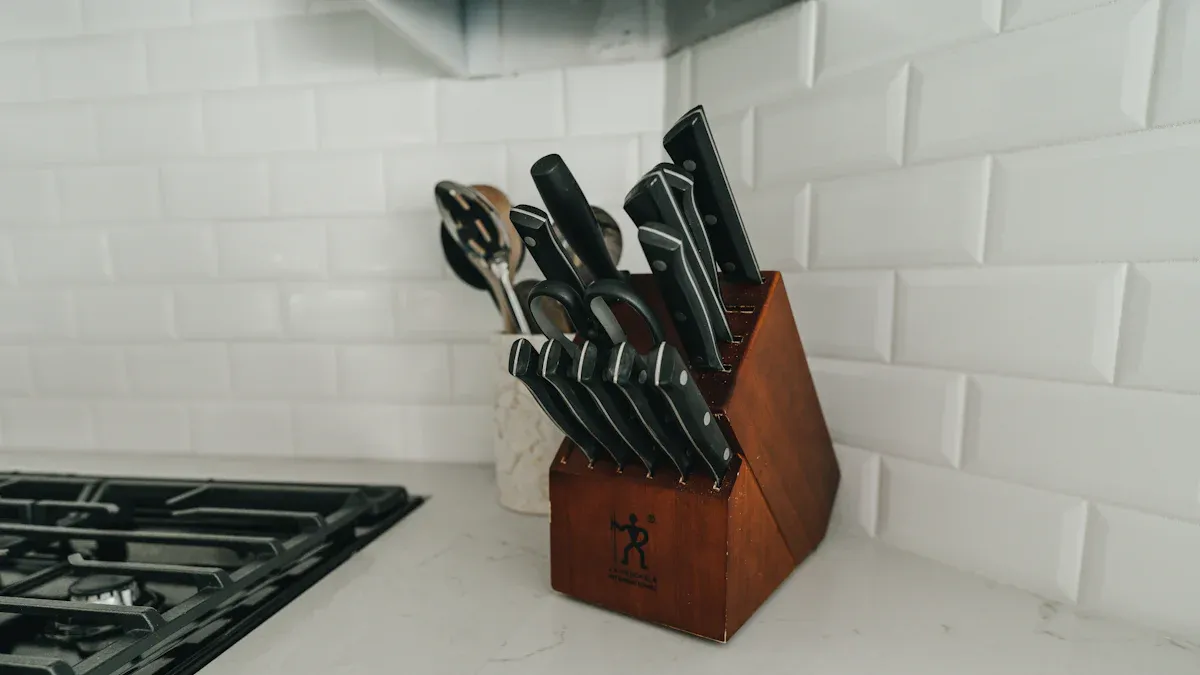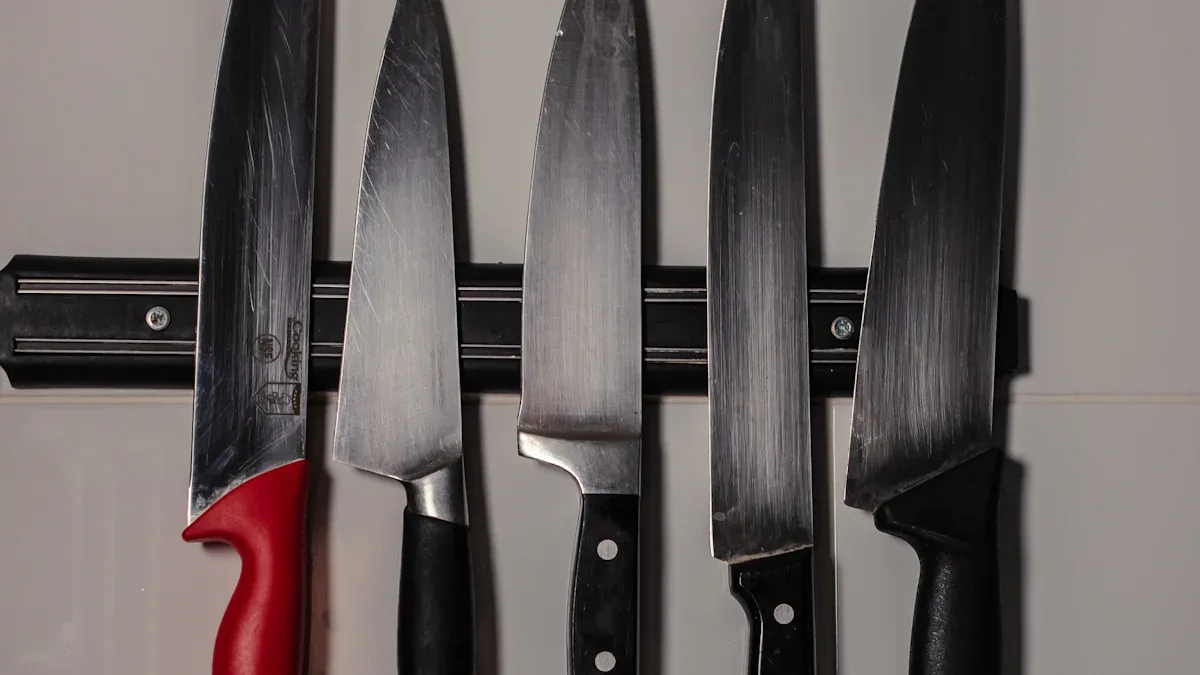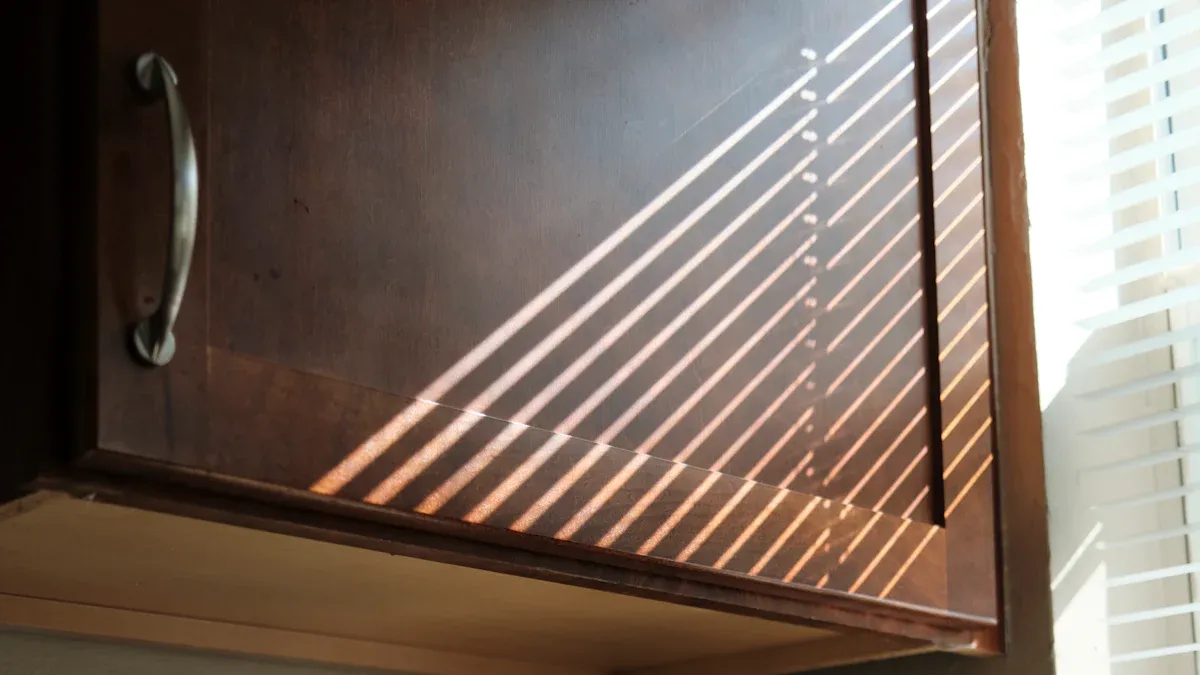
Magnetic knife racks play a crucial role in kitchen safety. Strong magnets keep knives securely in place, reducing the risk of accidents. Quality materials ensure durability, making these tools last longer. Design matters too; a stylish magnetic knife holder for wall can enhance kitchen aesthetics. Additionally, a magnetic knife stand can provide a convenient way to store your knives. On top of that, easy installation helps users set up their magnetic kitchen hooks without hassle. Lastly, using magnetic hooks for refrigerator organization can further optimize your kitchen space. Maintaining these racks is simple, ensuring they stay functional for years to come.
Key Takeaways
- Strong magnets are essential for securely holding knives. Choose neodymium magnets for optimal strength and safety.
- Material quality matters. Wooden racks offer durability and protect knife edges, while metal racks provide strength and functionality.
- Design aesthetics enhance your kitchen. Select between modern and traditional styles to match your decor and personal taste.
- Installation should be easy. Wall-mounted racks save counter space, while countertop options offer flexibility and display.
- Regular maintenance keeps your rack functional. Clean it every few weeks to prevent buildup and ensure longevity.
Magnetic Knife Rack Strength

When it comes to magnetic knife racks, strength is a key feature. The type of magnets used directly affects how securely knives stay in place. Let’s dive into the different types of magnets and how to test their magnetic hold.
Types of Magnets Used
Most magnetic knife racks in 2025 utilize neodymium magnets. These magnets are known for their impressive strength. They can hold heavier knives without slipping. In contrast, ferrite magnets are weaker and better suited for lighter applications, like refrigerator magnets.
Here’s a quick look at some common types of neodymium magnets used in magnetic knife racks:
| Magnet Type | Best for Wood Thickness | Diameter | Thickness | Strength |
|---|---|---|---|---|
| D83 | 1/16″ (1.6mm) | 1/2″ | 3/16″ | 9.14lb |
| DA4 | 1/8″ (3.2mm) | 5/8″ | 1/4″ | 15.3lb |
| DF4 | 1/4″ (6.4mm) | 15/16″ | 1/4″ | 25lb |
These magnets provide varying levels of strength, making them suitable for different knife sizes and weights. For securely holding chef knives, it’s recommended to use N52 neodymium magnets with a minimum pull strength of 6lbs each. This ensures that even the heaviest knives stay firmly in place.
Testing Magnetic Hold
Testing the magnetic hold of a knife rack is essential for safety. A simple way to do this is by checking how well the rack holds various knives. Start with lighter knives and gradually move to heavier ones. If a knife slips or falls, the magnetic strength may not be sufficient.
To ensure optimal performance, consider these tips:
- Check the weight: Always know the weight of your knives. If they exceed the magnet’s holding capacity, they might not stay secure.
- Inspect the surface: Make sure the knife rack is clean and free from debris. A dirty surface can weaken the magnetic hold.
- Test regularly: Over time, magnets can lose strength. Regularly test your magnetic knife rack to ensure it remains effective.
By understanding the types of magnets used and how to test their strength, users can choose the right magnetic knife rack for their kitchen needs.
Magnetic Knife Rack Material Quality

When choosing a magnetic knife rack, the material quality plays a significant role in both functionality and aesthetics. In 2025, two popular options dominate the market: wood and metal. Each material has its unique advantages and considerations.
Wood vs. Metal Options
Wooden magnetic knife racks are known for their durability and visual appeal. They often feature a warm, natural look that can complement various kitchen styles. Many users appreciate how wood can enhance the overall decor of their kitchens. On the other hand, metal racks are favored for their strength and functionality. They typically hold knives securely and can withstand heavy use.
Here’s a quick comparison of the two materials:
| Material | Description | Popularity in 2025 |
|---|---|---|
| Wood | Durable and aesthetically pleasing | High |
| Metal | Strong and functional | High |
Consumer reviews indicate that cheaper metal magnetic knife racks tend to be less durable and can potentially damage knife edges. In contrast, well-designed wooden racks provide better protection for knives. They often feature thicker wooden parts that prevent the blades from scraping against metal surfaces. This makes wooden racks a preferred choice for many home cooks who want to keep their knives in top condition.
Resistance to Wear and Tear
Both wood and metal magnetic knife racks face challenges regarding wear and tear. Understanding these issues can help users make informed choices.
Here’s a look at some common problems reported with material wear and tear in magnetic knife racks:
| Issue Type | Description |
|---|---|
| Demagnetization | Heat can demagnetize magnets, with lower heat causing reversible damage and higher heat causing permanent damage. |
| Mechanical Stress | Vibration and impacts can lead to a loss of magnet strength over time. |
| Interference | Exposure to other magnetic fields can also affect the performance of the magnets in the rack. |
For instance, stainless steel magnetic knife racks offer good resistance to rust, making them suitable for high humidity areas. Their durability ensures they can handle the rigors of daily kitchen use without succumbing to corrosion.
Magnetic Knife Rack Design Aesthetics
When it comes to magnetic knife racks, design aesthetics play a big role in how they fit into your kitchen. In 2025, homeowners have two main styles to choose from: modern and traditional. Each style offers unique benefits that cater to different tastes and needs.
Modern vs. Traditional Styles
Modern magnetic knife racks focus on functionality and hygiene. They often feature sleek designs that save counter space and enhance organization. For example, wall-mounted magnetic strips are popular because they keep knives easily accessible while maintaining a clean look. These designs also prevent moisture retention, making them easy to clean and reducing the risk of bacteria buildup.
On the other hand, traditional magnetic knife racks bring a warm, classic feel to the kitchen. They often use rich woods and intricate designs that appeal to those who appreciate craftsmanship. However, there’s been a noticeable shift in consumer preference towards modern styles. Many people now prefer organized and clutter-free spaces, especially in urban areas where kitchen size is limited.
Color and Finish Choices
Color and finish choices can greatly impact the overall look of a magnetic knife rack. Modern racks often come in sleek metallic finishes or bold colors that stand out against kitchen walls. These options allow homeowners to express their personal style while keeping their knives secure.
Traditional racks, however, typically feature natural wood finishes that highlight the beauty of the material. These warm tones can complement a variety of kitchen decors, from rustic to contemporary.
Ultimately, whether you lean towards modern or traditional styles, the right magnetic knife rack can enhance your kitchen’s aesthetics while providing practical storage solutions.
Magnetic Knife Rack Installation Ease
Installing a magnetic knife rack can be a straightforward task, but choosing the right type can make all the difference. Homeowners often face a choice between wall-mounted and countertop options. Each has its perks.
Wall-Mounted vs. Countertop Options
Wall-mounted magnetic knife racks save valuable counter space. They keep knives within easy reach while freeing up surfaces for food prep. This option works well in smaller kitchens where every inch counts. On the other hand, countertop magnetic knife racks offer flexibility. They can be moved around as needed and provide a stylish display for your favorite knives.
Both options have their advantages, so it really depends on your kitchen layout and personal preference. Do you want to maximize space or showcase your knife collection?
Installation Tools and Requirements
Installing a magnetic knife rack requires a few basic tools. Here’s a quick list of what you’ll need:
- Knife rack
- 2 screws appropriate for the mounting surface
- Tape measure
- Hammer (if using drywall anchors)
- Impact driver
- Drill
Before starting, measure the area where you plan to install the rack. Make sure it’s at a comfortable height for easy access. If you’re going with a wall-mounted option, use the tape measure to mark where the screws will go.
Tip: Always double-check your measurements before drilling. A small mistake can lead to misalignment, which can be frustrating.
Once you have everything ready, follow the instructions that come with your magnetic knife rack. With the right tools and a little patience, you’ll have your knives organized and displayed beautifully in no time!
Magnetic Knife Rack Maintenance
Keeping a magnetic knife rack clean and well-maintained is essential for both safety and longevity. Regular maintenance helps prevent buildup and ensures that your knives stay secure. Here are some helpful cleaning and care tips to keep your magnetic knife rack in top shape.
Cleaning and Care Tips
To maintain your magnetic knife rack, follow these steps:
- Remove the Kitchen Knives: Carefully take out the knives one by one to avoid accidents.
- Dry Clean the Inside with a Pipe Cleaner: Shake out dust and use a small brush to clean the slots.
- Clean the Outside of the Block: Use a damp cloth with dish soap to scrub the exterior gently.
- Remove All the Moisture: Avoid soaking the block in water to prevent swelling.
- Let Your Knife Block Dry: Pat it down and let it dry in a low-humidity area for several hours.
- Bleach out Bacteria from the Knife Block: Use a diluted bleach solution to sanitize the block.
Cleaning your magnetic knife rack every four to six weeks can help maintain its performance. Regularly cleaning the magnetic holder with a damp cloth eliminates dust and food particles. If you notice any rust, a baking soda and water mixture can help scrub it away. Always lift knives gently instead of dragging them across the surface to prevent scratches.
Longevity of Materials
Environmental factors can significantly impact the longevity of your magnetic knife rack. Here are some tips to protect it:
- Storing knives in a cool, dry place helps avoid exposure to humidity, which can lead to mold growth on storage materials.
- Regular inspection and maintenance of storage options can mitigate the effects of humidity.
- Avoiding moisture and humidity can prevent corrosion and rust formation on knives, directly impacting their lifespan.
By following these maintenance tips, you can ensure that your magnetic knife rack remains functional and visually appealing for years to come.
In summary, the top features of a magnetic knife rack include strong magnets, quality materials, appealing designs, ease of installation, and low maintenance. These elements not only enhance safety but also improve organization and aesthetics in the kitchen. Choosing the right magnetic knife rack is essential for ensuring that knives stay secure and accessible.
When selecting one, consider your personal needs and the style of your kitchen. A well-chosen magnetic knife rack can transform a cluttered space into an organized haven, making cooking more enjoyable and efficient.
Remember, a safe and stylish kitchen starts with the right tools!
FAQ
What is a magnetic knife rack?
A magnetic knife rack is a kitchen tool that uses magnets to hold knives securely. It keeps knives accessible while saving counter space. These racks come in various materials and designs to fit different kitchen styles.
How do I install a magnetic knife rack?
To install a magnetic knife rack, gather basic tools like screws and a drill. Measure the desired height, mark the spots for screws, and drill holes. Then, secure the rack to the wall or countertop as per the instructions.
Can I use a magnetic knife rack for other kitchen tools?
Yes! Magnetic knife racks can hold other metal kitchen tools, like scissors or spatulas. Just ensure the items are not too heavy for the magnets. This versatility helps keep your kitchen organized.
How do I clean my magnetic knife rack?
Cleaning a magnetic knife rack is simple. Remove the knives, wipe the surface with a damp cloth, and dry it thoroughly. Avoid soaking the rack to prevent damage, especially if it’s wooden.
Are magnetic knife racks safe for children?
While magnetic knife racks keep knives accessible, they may pose a risk for young children. It’s best to install them out of reach or use childproofing measures to ensure safety in the kitchen.
Post time: Oct-09-2025
